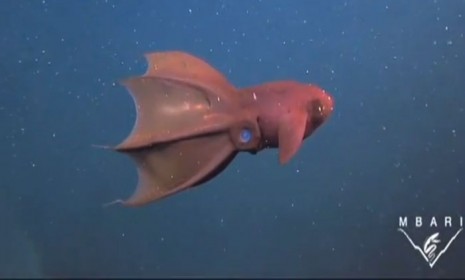The vampire squid that feasts on feces and mucus
A bizarre-looking sea creature lurking 3,000 feet below the surface doesn't eat other animals. Instead, it acts as "the garbage disposal of the ocean"

Vampyroteuthis infernalis, literally the "vampire squid from hell," doesn't prey on other marine life, in spite of its terrifying name. In fact, a new study from researchers at the Monterey Bay Aquarium Research Institute suggests that the mysterious deep-sea "living fossil" harmlessly subsists primarily on the ocean's waste products, including fecal matter and discarded shells. Here's what you should know about this strange creature:
Why is it called a living fossil?
"Living fossils are animals that have been on Earth for ages," says Jennifer Viegas at Discovery News, "surviving all major extinction events and not seeming to change very much over millions of years." The foot-long cephalopod — a category that includes squid and octopi — brandishes an umbrella-like cloak and lives 3,000 feet below the surface, where there is very little oxygen. Part of the secret to its longevity, say researchers, is its "eclectic diet," which allows the vampire squid to avoid competing with other predators.
The Week
Escape your echo chamber. Get the facts behind the news, plus analysis from multiple perspectives.

Sign up for The Week's Free Newsletters
From our morning news briefing to a weekly Good News Newsletter, get the best of The Week delivered directly to your inbox.
From our morning news briefing to a weekly Good News Newsletter, get the best of The Week delivered directly to your inbox.
What does it eat?
Scientists didn't know until the team scoured 24 hours of video tape of vampire squid in their natural environments over the last 20 years. They also analyzed the digestive tracts of aquarium specimens to see what was inside. "Instead of containing chewed-up fish or crustaceans" like most other cephalopods, the vampire squid consumed scraps like "fish eggs, bits of crustacean antennae and eyes and legs, larvae, and even larvae feces," says Stephanie Pappas at LiveScience. In essence, they're the "garbage disposals of the ocean."
How can the vampire squid possibly digest this junk?
To find out, researchers sprinkled dead animal particles in fish tanks containing the squid. The team "witnessed the cephalopod extend a fine, long filament from its umbrella-like mouth," which extends eight times its body length, says Liat Clark at Wired. Debris sticks to the filament, which is then retracted. The vampire squid then coats the tiny scraps in mucus secreted from its suckers, and places the glued-together garbage in its mouth.
A free daily email with the biggest news stories of the day – and the best features from TheWeek.com
Do any other animals eat like this?
Not that we know of. "Vampire squid have always had these really funny long things that stick out of their body, and scientists like me had no idea what they were used for," says researcher Richard Yong, a biological oceanographer from the University of Hawaii. "I would be shocked if any other marine organism ate in such a way."
Sources: Discovery News, LiveScience, Wired
-
 ‘Care fractures after birth’
‘Care fractures after birth’instant opinion Opinion, comment and editorials of the day
-
 Shots fired in the US-EU war over digital censorship
Shots fired in the US-EU war over digital censorshipIN THE SPOTLIGHT The Trump administration risks opening a dangerous new front in the battle of real-world consequences for online action
-
 What will the US economy look like in 2026?
What will the US economy look like in 2026?Today’s Big Question Wall Street is bullish, but uncertain